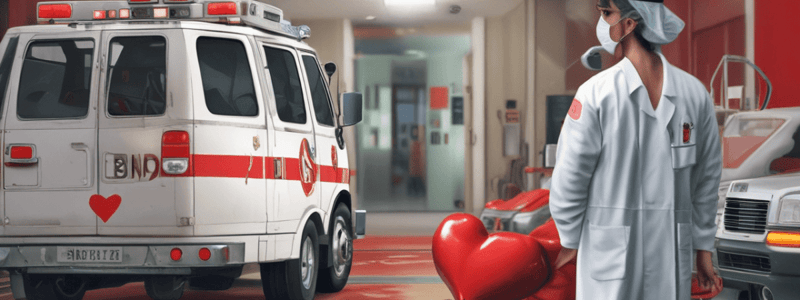Podcast
Questions and Answers
What should you prioritize when a patient presents with no relief with medications or hypotension?
What should you prioritize when a patient presents with no relief with medications or hypotension?
- Recognize a sense of urgency for reperfusion (correct)
- Perform a primary survey to assess the patient's condition
- Provide emotional support to the patient and their family
- Determine the chief complaint and history of present illness
What should you assess for during the full-body scan?
What should you assess for during the full-body scan?
- Major bleeding or substantial edema in dependent areas (correct)
- Pulse and respiratory rate
- Signs of cardiac arrest
- Patient's cardiovascular history
What should you do if the patient is pulseless, apneic, and unresponsive?
What should you do if the patient is pulseless, apneic, and unresponsive?
- Apply the AED and start compressions (correct)
- Perform a secondary assessment to evaluate circulation
- Determine the chief complaint and history of present illness
- Administer oxygen and provide emotional support
Why is it important to ask follow-up questions during the patient assessment?
Why is it important to ask follow-up questions during the patient assessment?
What should you consider using during the patient assessment?
What should you consider using during the patient assessment?
What should you base your transport decision on?
What should you base your transport decision on?
What is the significance of rapid defibrillation in the treatment of cardiac arrest?
What is the significance of rapid defibrillation in the treatment of cardiac arrest?
What is the primary purpose of comparing blood pressure readings in both arms?
What is the primary purpose of comparing blood pressure readings in both arms?
What is the recommended time frame for acquiring an EKG in patients with chest pain or discomfort?
What is the recommended time frame for acquiring an EKG in patients with chest pain or discomfort?
Why is it important to reassess the patient after administering nitroglycerin?
Why is it important to reassess the patient after administering nitroglycerin?
What is the purpose of reviewing each incident in which an AED is used?
What is the purpose of reviewing each incident in which an AED is used?
What is the purpose of an LVAD in patients with severe heart failure?
What is the purpose of an LVAD in patients with severe heart failure?
Flashcards are hidden until you start studying
Study Notes
-
As you prepare to perform a patient assessment on cardiac patients, it's crucial to recognize a sense of urgency for reperfusion when the patient receives no relief with medications or presents with hypotension or signs of hypoperfusion.
-
Provide emotional support to the patient and an explanation for the family or significant others if time allows.
-
Ensure scene safety, address any hazards, determine the number of patients, and identify the nature of illness.
-
Perform a primary survey to form a general impression of the patient's condition and recognize life threats, which can be done by performing a rapid full-body exam and checking ABCs.
-
If the patient is pulseless, apneic, and unresponsive, apply the AED and start compressions.
-
During the full-body scan, assess for major bleeding or substantial edema in dependent areas and consider the use of CPAP early on.
-
Make a transport decision based on whether life threats were stabilized and present.
-
Determine and investigate the chief complaint and history of present illness, as not all patients experiencing an MI have the same signs and symptoms.
-
Ask follow-up questions to obtain a sample history, including cardiovascular-related questions such as previous heart attacks, heart problems, angina, heart failure, or heart disease.
-
Evaluate the patient's circulation in-depth during the secondary assessment and assess for signs of inadequate ventilation.
-
Reassess the level of consciousness, record and measure vital signs, and obtain blood pressure readings in both arms to compare for stroke or possible aortic aneurysms.
-
Repeat vital signs at appropriate intervals based on the patient's condition and report to the hospital while in route.
-
For patients with chest pain or discomfort, treatment begins with proper positioning, oxygen provision, and EKG acquisition within 10 minutes of patient contact.
-
Gain IV access, prepare to administer aspirin and nitroglycerin as prescribed, and monitor for adverse effects.
-
When administering nitroglycerin, check the medication's condition and expiration date, wear gloves, and reassess the patient for adverse effects.
-
Heart surgeries and cardiac assisted devices, such as open heart procedures, coronary artery bypass grafts, and pacemakers, require special consideration during patient assessment.
-
Patients with automatic implantable cardiac defibrillators or external defibrillator vests require prompt transportation and treatment like any other heart attack patient.
-
Left ventricular assist devices (LVADs) enhance the pumping of the left ventricle in patients with severe heart failure and require special care during transportation.
-
Cardiac arrest is defined as the complete cessation of functional cardiac activity and requires prompt treatment with AEDs.
-
AEDs can automatically administer an electrical shock to the heart when needed and are user-friendly, with voice prompts guiding the operator through the process.
-
The rationale for early defibrillation lies within the six links in the chain of survival: recognition of early warning signs, immediate activation of EMS, implementation of immediate CPR, rapid defibrillation, basic and advanced EMS care, and post-arrest care.
-
Rapid defibrillation is the greatest determinant for survival, and AEDs can deliver a shock within 1 minute.
-
CPR should be performed with high-quality chest compressions, and the AED should be used according to the manufacturer's instructions.
-
Review each incident in which an AED is used, and report any problems to the manufacturer and the US Food and Drug Administration.
Studying That Suits You
Use AI to generate personalized quizzes and flashcards to suit your learning preferences.




